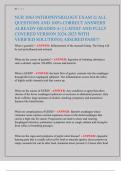1|Page
NUR 2063 PATHOPHYSIOLOGY EXAM 2|| ALL
QUESTIONS AND 100% CORRECT ANSWERS
ALREADY GRADED A+|| LATEST AND FULLY
COVERED VERSION 2024-2025 WITH
VERIFIED SOLUTIONS|| ASSURED PASS!!!
What is gastritis? - ANSWER: Inflammation of the stomach lining. The lining will
be red and inflamed and irritated
What are the causes of gastritis? - ANSWER: Ingestion of irritating substances
such a alcohol, aspirin, NSAIDS, viruses and bacteria
What is GERD? - ANSWER: the back flow of gastric contents into the esophagus
through the lower esophageal sphincter. The inflammation occurs from the reflex
of highly acidic stomach acid that comes up.
What are the causes of GERD? - ANSWER: Any condition or agent that alters
closure of the lower esophageal sphincter or increases in abdominal pressure, fatty
food, caffeine, large amounts of alcohol, smoking, pregnancy and anatomical
features like hiatal hernia
What are complications of GERD? - ANSWER: Barrett's esophagus where
columnar tissue replaces normal squamous tissue in the distal esophagus that
carries a high risk for cancer. Progression can lead to ulcers and scarring.
Esophageal strictures, pulmonary symptoms such as cough, asthma and laryngitis
from reflux in breathing passages.
What are the signs and symptoms of peptic ulcer disease? - ANSWER: epigastric
burning pain that is usually relieved by food or antacids (gastric ulcers present on
empty stomach but can be after food, duodenal ulcers present 2-3 hours after food
,2|Page
and is relieved by food). Can also be life threatening as GI bleeding can occur
without warning and cause a drop in H/H and dark tarry stools and hematemesis.
What is the role of H.pylori in peptic ulcer disease? - ANSWER: promotes both
gastric and duodenal ulcer formation and thrives in acidic areas. It slows down
ulcer healing and can reoccur frequently, and taking it away can help ulcers heal.
What is pseudomembranous colitis?(C.diff) - ANSWER: acute inflammation and
necrosis of large intestine. The intestinal lining cannot absorb well.
What is the cause of pseudomembranous colitis? - ANSWER: clostridium
difficile, exposure to long term antibiotics that off set the e.coli and c.diff balance
in intestine
What are the manifestations of pseudomembranous colitis? - ANSWER: foul
smelling/bloody stool, abdominal pain, fever, leukocytosis, sepsis, colonic
perforation.
How do we treat pseudomembranous colitis? - ANSWER: stop current antibiotics,
treat ischemia and contributing conditions, give oral antibiotics like metronidazole
or vancomycin, fecal transplant or colectomy if severe
How do we prevent the spread of pseudomembranous colitis? - ANSWER:
wearing appropriate PPE and washing hands with soap and water only
What are the signs and symptoms of appendicitis? - ANSWER: Periumbilical
pain, RLQ pain, presence of a positive McBurneys point with pain, nausea,
vomiting, fever, diarrhea, RLQ tenderness, systemic signs of infection
, 3|Page
How do we assess for appendicitis? - ANSWER: McBurney's point technique
when pressing on the belly button and RLQ hip region and removing the pressure
causes intense pain, indicates positive appendicitis
What are the causes of bowel obstructions? - ANSWER: previous surgery of the
intestines with adhesions, congenital abnormalities of the bowel, metastatic cancer
of the intestinal tract or female reproductive organs, accumulation of fluid, gas,
water and electrolytes in the bowel.
What is a functional bowel obstruction? - ANSWER: a problem with the act of the
bowel actually moving, such as things that inhibit movement from surgery,
medications, opioids, low fiber diets that can slow motility or shut off the GI
system from the SNS stimulation.
What is a mechanical bowel obstruction? - ANSWER: due to adhesions, hernia,
tumors, impacted feces, volvus or twisting of the intestines, intussusception
What are the signs and symptoms of liver disease? - ANSWER: hepatocellular
failure (jaundice, decreased clotting, hypoalbuminemia, decreased vitamin D and
K) and portal hypertension (GI congestion due to blockage of blood, more
esophageal or gastric varies, hemorrhoids, enlarged spleen,)
Explain what jaundice is? - ANSWER: green- yellow staining of tissues from
increased level of bilirubin as the liver cannot metabolize extra bilirubin
Where can you find jaundice on assessment? - ANSWER: eyes, skin, and mouth
Explain what ascites is? - ANSWER: pathological accumulation of fluid in the
peritoneal cavity due to the loss of albumin in the liver, causing fluid to be free




